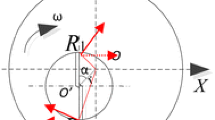Abstract
This paper presents the development of a cutting force model for the micro-end-milling processes under various cutting conditions using a hybrid approach. Firstly, a finite element (FE) model of orthogonal micro-cutting with a round cutting edge is developed for medium-carbon steel. A number of finite element analyses (FEA) are performed at different uncut chip thicknesses and velocities. Based on the FEA results, the cutting force coefficients are extracted through a nonlinear algorithm to establish a relationship with the uncut chip thickness and cutting speed. Then, the cutting force coefficients are integrated into a mechanistic cutting force model, which can predict cutting forces under different cutting conditions. In order to account for the cutting edge effect, an effective rake angle is employed for the determination of the cutting force. A comparison of the prediction and experimental measured cutting forces has shown that the developed method provides accurate results.
Similar content being viewed by others

References
Vasile MJ, Friedrich CR, Kikkeri B, McElhannon R (1999) Micrometer-scale machining: tool fabrication and initial results. Precis Eng 19:180–186
Weule H, Huntrup V, Tritschle H (2001) Micro-cutting of steel to meet new requirements in miniaturization. Ann of the CIRP 50(1):61–64
Ko JH, Cho DW (2004) Feed rate scheduling model considering transverse rupture strength of a tool for 3D ball-end milling. Int J Mach Tools and Manuf 44(10):1047–1059
Van Luttervelt K, Childs THC, Jawahir IS, Klocke F, Venuvinod PK (1998) Present situation and future trends in modelling of machining operations. CIRP Ann-Manuf Technol 47(2):587–626
Markopoulos AP (2013) Finite element method in machining processes, SpringerBriefs in manufacturing and surface engineering, doi: 10.1007/978-1-4471-4330-7, Springer London Heidelberg New York Dordrecht
Martellotti ME (1941) An analysis of the milling process. Trans ASME 63:677–700
Sabberwal AJP (1961) Chip Section and cutting force during the milling operation. CIRP Ann 10(3):62
Tlusty J, Macneil P (1975) Dynamics of cutting forces in end milling. Ann CIRP 24(1):21–25
Kline WA, DeVor RE, Lindberg JR (1982) The prediction of cutting forces in end milling with application to concerning cuts. IJMTDR 22(1):7–22
Afazov SM, Ratchev SM, Segal J (2010) Modelling and simulation of micro-milling cutting forces. J Mater Process Technol 210(15):2154–2162
Vogler MP, DeVor RE, Kapoor SG (2003) Microstructure-level force prediction model for micro-milling of multi-phase materials. J Manuf Sci Eng 125(2):202–209
Vogler MP, DeVor RE, Kapoor SG (2004) On the modelling and analysis of machining performance in micro-endmilling, part ii: cutting force prediction. J Manuf Sci Eng 126(4):695–705
Zaman MT, Senthil Kumar A, Rahman M, Sreeram S (2006) A three-dimensional analytical cutting force model for micro end milling operation. J Machining Tools & Manuf 46(3-4):353–366
Lee HU, Cho DW, Ehmann KF (2008) A mechanistic model of cutting forces in micro-end-milling with cutting-condition-independent cutting force coefficients. J Manuf Sci and Engineerin 130(3):031102
Lai XM, Li HT, Li CF, Lin ZQ, Ni J (2008) Modelling and analysis of micro scale milling considering size effect, micro cutter edge radius and minimum chip thickness. J MachTools and Manuf 48(1):1–14
Malekian M, Park SS, Jun MBG (2009) Modeling of dynamic micro-milling cutting forces. J Mach Tools & Manuf 49(7-8):586–598
AltintasY. (2000) Manufacturing Automation, Cambridge University Press
Budak E, Altintas Y, Armarego EJA (1996) Prediction of milling force coefficient from orthogonal cutting data. J Manuf Sci Eng 118(2):216–224
Li HZ, Liu K, Li XP (2001) A new method for determining the undeformed chip thickness in milling. J Mater Proc Technol 113(15):378–384
Li HZ, Li XP (2005) A numerical study of the effects of cutter runout on milling process geometry based on true tooth trajectory. Int J Adv Manuf Technol 25:435–443
Fang FZ, Liu YC (2004) On minimum exit-burr in micro cutting. J Micromechanical Microengineering 14(7):984–988
Sartkulvanich P, Atlan T (2005) Effects of flow stress and friction models in finite element simulation of orthogonal cutting—a sensitivity analysis. Mach Sci Technol 9(1):1–26
Johnson GR, Cook WH (1983) A constitutive model and data for metals subjected to large strains, high strain rates and high temperatures. 7th International Symposium on Ballistics, Hague, Netherlands. 541-547
Author information
Authors and Affiliations
Corresponding author
Rights and permissions
About this article
Cite this article
Jing, X., Li, H., Wang, J. et al. Modelling the cutting forces in micro-end-milling using a hybrid approach. Int J Adv Manuf Technol 73, 1647–1656 (2014). https://doi.org/10.1007/s00170-014-5953-x
Received:
Accepted:
Published:
Issue Date:
DOI: https://doi.org/10.1007/s00170-014-5953-x



